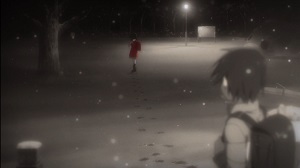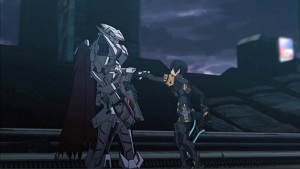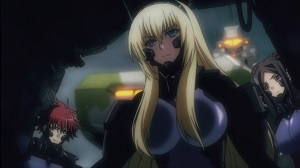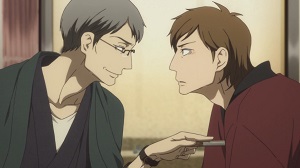written by Laurie Tom
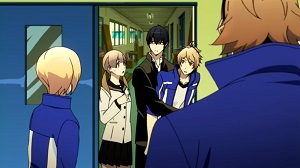 Out of all sports anime I could have watched as my first, I picked Prince of Stride: Alternative because I was a track and field athlete in high school, and the idea of a parkour/relay race would totally have been up my alley.
Out of all sports anime I could have watched as my first, I picked Prince of Stride: Alternative because I was a track and field athlete in high school, and the idea of a parkour/relay race would totally have been up my alley.
There are really two elements to the show. One is the story that follows the stride club of Honan Academy. The other is the sport itself.
Most of the characters aren’t terribly deep, but considering that this is more about the team rather than any one character’s experience I think that’s all right. This series is based on a visual novel aimed at the female audience (explaining the pleasing character designs of the male athletes), but to be honest I’m really watching for stride and showrunners seem to have taken the tack of making this a sports series. There’s no romance at all. Just friendship.
Stride is a made-up sport consisting of a five man relay team plus a relationer, for a total of six. The race is run through urban environments with a number of obstacles referred to as “gimmicks” in the way. There can be narrow bridges to prevent passing, boxes that must be vaulted over, etc.
The relationer comes in play during the most contrived part of the race, which would be the handoff in a regular relay race (but they high-five instead of using a baton in stride). Since this is on city streets and not a race track, the next runners in the relay cannot necessarily see the speed or direction their teammates are approaching. Generally they’ll start running at an angle compared to the main race track and then race into the track and takeover zone where they need to high five.
Since it’s a blind start, the relationer calls out the approach and how much of a lead they or their opponent have before cueing the next runner for a ready, set, go. A good relationer should be like the team strategist, making decisions based on how their runners are doing and advising whether high risk high reward shortcuts are necessary. However, in practice Nana, the only female cast member and Honan’s relationer, hardly ever does this.
The races are dramatic and individually well choreographed, though after a while it’s a little surprising that there aren’t more races that are plain blowouts one way or another. I realize that’s not as dramatic as a down to the wire finish, but having seen a lot of high school relays, I know it happens from time to time. Even a hint of those off camera would have been nice.
Perhaps because of my background I found there were some elements of the sport that I didn’t necessarily understand. Several times I would see characters jumping around for no reason, or going around an obstacle that was clearly in their path when it seems like they should be obligated to go over it. There doesn’t appear to be a scoring system other than time, so unnecessary jumping should actually be bad (as a hurdler, I learned to spend as little time in the air as possible), but there are times where they jump around in preference to straight running.
When the show is not focusing on the races themselves, they’re usually focused around team building, either through training or by having the five boys and Nana hang out together. Most of the show’s focus is on Nana, Takeru, and Riku, who are the three first years who join the stride club at the start of the school year when it’s on the verge of nonexistence.
In addition to the races, there is a subplot involving previous members of the stride club and how Honan’s stride team dropped to the point that without the new first years they couldn’t field a full team. It’s probably not the strongest storyline and only necessary because otherwise Takeru and Nana wouldn’t have gone to Honan in the first place to become talented but plucky underdogs (enrolling because Honan was renowned for stride).
Prince of Stride is strongest when it focuses on the more realistic parts of races and what it’s like being part of a sports team. The animation is by the studio Madhouse, which regularly turns in beautiful work (like last year’s Death Parade), and captures the energy of being in a race and screaming for teammates all the way down to the finish line.
The rest of it can be pretty forgettable, and I wish the production had focused more on the sports part of the show than the interludes where the team is horsing around. They face a lot of other teams on their way to the End of Summer race finals, and while it’s not realistic for them to get to know every set of opponents, even their rival team doesn’t have much opportunity to be more than a few surprisingly friendly faces. More stride would have fixed that, and I actually was a little disappointed in the episodes that didn’t have any races.
Still, it was a fun watch, and I’d recommend it to anyone who’s been through high school team sports. There was a lot of nostalgia in this one.
Number of Episodes: 12
Pluses: exciting and well animated races, excellent soundtrack
Minuses: non-stride segments can get pretty goofy, other than Nana there is a serious lack of recurring female characters
Prince of Stride: Alternative is currently streaming at Funimation and Hulu and is available both subtitled and dubbed (though dub requires a Funimation subscription). Funimation has licensed this for eventual retail distribution in the US.

Laurie Tom is a fantasy and science fiction writer based in southern California. Since she was a kid she has considered books, video games, and anime in roughly equal portions to be her primary source of entertainment. Laurie is a previous grand prize winner of Writers of the Future and since then her work has been published in Galaxy’s Edge, Strange Horizons, and the Year’s Best YA Speculative Fiction.

